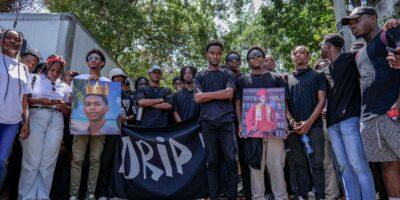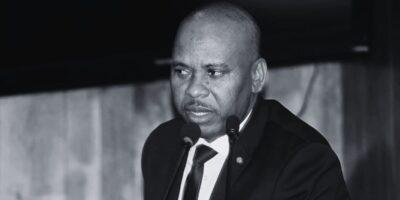This does not mean that all Haitians are Vodou practitioners
Since the ceremony of Bois Caïman is considered the founding myth of the Republic of Haiti, it would be impossible to talk about Haiti without mentioning Vodou. It permeates through every aspect of Haitian society. Like a tree that cannot be uprooted from the Haitian collective imagination. However, this does not mean that all Haitians are Vodou practitioners. I write this article as neither a former or present practitioner. I am a Catholic and am deeply rooted in my Catholic faith.
Look no further than the international stage for a view of Haitian Vodou, especially in the world of cinematography (Hollywood with its zombie movies), or even within Haiti (considering the 1939 anti-superstition campaign), to understand that Vodou is often misconceived. In the scholarly and artistic world (with the exception of the scholars’ movement initiated by Jean Price Mars), Vodou is portrayed in the Christian or anti-Vodou sphere, in the vast majority of cases, by unsavory paintings depicting bloody scenes, fires, and a whole host of other images. The most ludicrous of which is the similarity drawn between Vodou and the devil. In other words, Vodou is closely linked to magic, orgies, witchcraft, charlatanism, or fetishism.
Vodou is often misconceived.
In the Christian public realm, (with few exceptions), talking about Vodou is a taboo. Any attempt to disclose a different way of perceiving Vodou is strong indication of endorsing evil. Vodou represents a dilemma! Nothing is more important than to hear “Christians” asserting that Vodou is at the origin of all the evils befalling Haiti, as if by its very essence, Vodou constitutes a stumbling block, a drawback for the development and progress of Haiti.
Read also: Vodou stands out from the sexism of Christian religions
At the religious level, Haiti is divided into two main groups. This includes the civilized Christians on one hand, and the barbaric Vodou practitioners on the other hand. In other words, the camp of those who claim to be servants of God and those who are damned because of their adherence to Vodou. The question therefore arises: Is it possible to achieve social cohesion in such a divided nation? Hearing about Vodou in the Haitian context, one may easily get the impression of a history underscored by overwhelming misunderstandings between the pro- and the anti-Vodou. On the basis of latter, this religious dispute is largely at the heart of issues affecting the Haitian collective. How then to reconcile the “barbaric and the civilized?”
Moreover, behind this dichotomy lies a rejection of the African cultural heritage, the shame of a conscience overwhelmed by representations of unsavory depictions of Vodou or simply a mechanism of exploitation that seeks to undermine the truth. Indeed, there are many Haitians who are still entrenched in their mental shackles. How is one to understand Vodou, beyond any ideological group, as a liberating movement against all forms of oppression and exploitation in the construction of a strong, but above all, a free nation?
In the Christian public realm, (with few exceptions), talking about Vodou is a taboo.
We must approach Haitian Vodou not as a religious doctrine or a practice, but as a gathering of men and women conscious of their condition; where Haitian Vodou is a catalyst for the liberation of an oppressed race. This approach is meant to be objective in order to draw from it all the necessary elements for a better understanding of the spirit of Vodou, rooted in the context of Bois Caïman. Social balance and appeasement cannot be found in the Haitian context by elucidating, in the light of reason, this religious struggle that is undermining the social ethos.
The Origin of Haitian Vodou
Hispaniola Island is located on the Caribbean Sea. Until the end of the 15th century, it was inhabited only by natives. Its population was, “At that time, an estimated several hundred thousand indigenous Arawak/Taino.” However, the arrival of Christopher Columbus in 1492 would be a major turning point in the history of this island. The curtailing of two liberties would become the order of the day (starting with the indigenous people, and later followed by the enslaved Africans). This unexpected arrival is at the root of the partition of the island into two republics: the Dominican Republic and the Republic of Haiti.
Within the arrival of Christopher Columbus, if one can believe it, it is said that he had received the order from the queen of Spain, in his mission of conquest, not to exterminate the Indigenous people, but rather to teach them the true religion: Christianity. R. Murray Thomas, professor emeritus at the University California, Santa Barbara, claims that: “Spain’s Queen Isabella… gave orders to erect a church in each community to convert the inhabitants to Catholicism, and build a school where the priest would teach Indian children to read, write, and recite simple Christian prayers.” Unfortunately, inhabited by unbridled greed, Columbus and his associates fostered the extermination of the Indians in less than a quarter of a century.
Within the arrival of Christopher Columbus, if one can believe it, it is said that he had received the order from the queen of Spain, in his mission of conquest, not to exterminate the Indigenous people, but rather to teach them the true religion: Christianity.
It was at the heart of this apocalyptic event, says Jean Kerboull, a member of the congregation of the Fathers of Saint James and professor of philosophy, that:
“One voice [however] was raised: that of a Dominican religious, Bartolomé de Las Casas. This priest, a former ‘descobridor’ who joined the order, vehemently disproved the enslavement of the Indians. He particularly castigated the ‘encomienda’, that is, the illegal redistribution of land taken from the indigenous people. Carried away by his impulse, he took the unfortunate initiative of proposing to call on Black Africans to relieve the Indians.”
Unfortunately for the Africans, the Spanish Crown, took him seriously for this substitution of labor. It was within the framework of this substitution that the “triangular trade” was inaugurated. This trade relied on one category of people: The Black. How many Africans were thus savagely taken away from their country? It can be said that tens of thousands of Blacks replaced, in slavery, a few thousand indigenous people.
Read also: Vodou: she was at Harvard when the « loas » of Haiti claimed her
Kerboull reports that: “The slave traders mainly loaded the Blacks along the Gulf of Guinea: the catch was practiced along the west African coast, from Senegal to Congo and Angola. It is worth pointing out that the Slave Coast, in the Gulf of Benin, was by far the most active trading post, as was Lagos and Ouidah especially, in the Kingdom of Judah.” Thomas maintains that: “The African sources of Haiti’s slaves were mainly west-central African territories, where the nations of Togo, Benin, and Nigeria are now located— a region known as the Slave Coast, populated by more than 40 ethnic groups speaking around 250 dialects.” The brewing of ethnicities took place in the melting pot of the colony.
The enslaved from different tribes were grouped according to their linguistic differences to avoid any plot against the slave master, and to prevent them from understanding each other or to make themselves understood. They were subjected to mechanisms of acculturation and deculturation: their birth names stripped and replaced by those of their slave masters or of Saints, and their beliefs by Christianity.
They were subjected to mechanisms of acculturation and deculturation.
Each tribe had its own divinity. Among the multiple divinities were “the list of the loas – divinity of Vodou – the trace of fifteen of them: from the Arada to the Fon, the Bissagots, Canga, Caplaou to the Congos, the Haoussa to the Ibos, passing through the Mandingo, Mines, Mondongues, Nago, Popo, Soussou and Senegalese.” In this configuration, as Joseph and Cleophat point out, “Haiti has developed a distinctive culture that is neither African nor European […]but an adulterated syncretic blending of African and European civilizations.” It is from this fusion that a common denominator emerged, where the different varieties met, not without ups and downs, at the religious level, the strongest point of their cultures: Vodou.
Vodou was to enable the enslaved to strengthen their spirituality and their sense of belonging to a common cause. Sociologist Gabriel Dorino, a Haitian Jesuit, says that “Haitian Vodou by its very essence expresses a demand for a community of meaning between those exploited and those excluded from the slave system.” However, European missionaries saw Vodou not as a salutary reaction to denial, but as a palpable manifestation of the devil. It is Vodou as a liberating force that will be the object of the next section. So what is Haitian Vodou?
Haitian Vodou
Public opinion has some abhorrent ideas about Vodou and there is a lengthy set of terms to talk about Haitian Vodou. For example, to convey Vodou terms such as: animism, fetishism, paganism, primitive, black magic, superstition, witchcraft, sorcery are used. I choose not to approach these caricatural images, not because it is unimportant, but in order to address the question: What is Haitian Vodou?
Haitian Vodou has its roots in the African culture but with a predominance of the Beninese Vodun. According to Beninese Jesuit, Barnabé Houguevou, “the word Vodun comes from ‘Vo’ which means ‘apart’ and ‘Dun’ which means ‘far beyond’, something that cannot be mastered or controlled since it is very far away.”
The Haitian word « Vodou » would be the adaptation of the Fon language spoken in Benin and a Yoruba word (a language spoken in certain regions of Benin, Nigeria, Togo or Ghana) meaning “god.” Haitian Vodou did not remain identical to what it was in Africa; it could not do so, given the context of slavery and the mixing of ethnic groups from the holds of slave ships.
Haitian Vodou has its roots in the African culture but with a predominance of the Beninese Vodun.
According to Harold Courlander, “Vodou is an integrated system of concepts concerning human conduct, governing humanity’s relationship with those who once lived and with the natural and supernatural forces of the universe.” Vodou can be understood as a complex and mystical worldview in which man, nature, and the invisible are intimately linked and in which the sacred and the temporal, the material and the spiritual are one. Wade Davis goes further than Courlander by saying “Vodou not only contains spiritual concepts, it prescribes a way of life, a philosophy and a code of ethics that regulate social behavior.”
By extension, Vodou can be defined as the set of gods or invisible forces whose power or benevolence men try to reconcile. It is the affirmation of a supernatural world, but also the set of procedures for relating to it. Vodou is a cult to the spirit of the world of the unseen that is in the grip of something. These definitions allow me to situate the momentum of Haitian Vodou at a particular event: The Ceremony of Bois Caïman.
Read also: A surge of young Haitians are being initiated into mystical societies. They explain why.
On the night of August 14, 1791, under the spiritual guidance of a great Vodou priest known as Boukman, a large number of enslaved people gathered in a clearing at Bois Caïman. The objective was to remove all hesitation by obtaining absolute devotion in order to break the yoke of slavery. To do this, Boukman had adopted a globalizing discourse that carried not only the suffering of the slaves, but also their aspirations and dreams to replace the dominant discourse of the slavers, which was based on one of St. Paul’s most remarkable syntheses of the Christian faith in the early Church: “Let each one remain in the condition he was in when he was called. Were you a slave… make good use of your condition as a slave…” (1 Cor 7:20). Thus, the masters saw religious education as the only outlet capable of containing the desire for the emancipation of slaves. To counteract this education, Boukman formulated the following speech:
“The Good Lord who created the sun which gives us light from above, who rouses the sea and makes the thunder roar–listen well, all of you–this god, hidden in the clouds, watches us. He sees all that the white people do. The god of the white people demands from them crimes; our god asks for good deeds. But this god who is so good demands vengeance! He will direct our hands; he will aid us. Throw away the image of the god of the whites who thirsts for our tears, and listen to the voice of liberty which speaks in the hearts of all of us.”
The masters saw religious education as the only outlet capable of containing the desire for the emancipation of slaves.
With this act, Boukman succeeded in making the slaves understand that the message preached by the prelates, and slave owners, was only for Whites and free men. Paradise was for the rich, both on earth and in heaven. And the poor slaves could reach heaven through their soul after death, if and only if that soul had been well mastered by inhuman work and a catechism of absolute submission.
Boukman denounced this ideologizing catechism by proposing a combative and warlike discourse that challenged a symbolically egalitarian community to a hierarchical and discriminatory Church and society. In this sense, the Ceremony of Bois Caïman symbolizes the momentum of an awareness that it is time to take ourselves seriously and that Vodou is the catalyst and breath of life, a saving energy against the slave system. Bois Caïman became the starting point of Haitian Vodou.
Indeed, the birth of Haitian Vodou and the development of its “theology” throughout the history of Haiti are none other than the stories that unmask the bias discourse of the so-called civilized and Christian slave settlers and that, at the same time, drove the African slaves, the outcasts of society, to seek another discourse and a spirituality that better conveys their aspirations, their joy, their pain, and their dreams. The historian Thomas Madiou acknowledges that Vodou had greatly contributed to the success of the slaves raised by over-exciting their fanaticism to the highest degree. God told them that if they perished in battle, they would go back to Africa, free and happy. So, their flesh blunted the iron of the whites.
Boukman succeeded in making the slaves understand that the message preached by the prelates, and slave owners, was only for Whites and free men.
After independence in 1804, the struggle for the recognition of Haiti focused on the Christianization of the country. That is why the first state which recognized Haiti, 60 years after its independence, as a free country was the Vatican. Missionaries started to arrive in Haiti. It is in this context that the missionaries began to describe Vodou as evil. The missionary clergy used the pretext that Vodou is a remnant of Africa, a cult in honor of the devil. They launched campaigns of persecution against its followers for its immediate and complete eradication. Through the veils of their bias, the missionaries succeeded in upholding Vodou as a deadly threat aimed at their destruction and the former created an unsettling environment for Vodou practitioners.
Read also: Perspective | The Roots of Tensions Between Haiti and the Dominican Republic
Since then, the rites associated with Vodou have been described as unworthy musings. At that time, under the orders of the Christians, gigantic blazes erased the symbols of Vodou which represented the Black resistance. The eradication of the Vodou cult had taken an official turn. However, the African beliefs buried deep in the popular soul resisted while the superficial Catholic tincture, imposed through violence since slavery, was flaking away.
A great successive campaign against Vodou was carried out with the aim not only of tarnishing its image by presenting it as an evil leech, but also striving for its complete eradication. For example, the American occupation of Haiti in 1915 favored the demonization of Vodou, because the occupiers were aware of the revolutionary character and emancipatory power of Vodou. Two leading Vodou priests were killed as was Boukman.
During the first American occupation of Haiti, some envoys made sure to spread the image of Haiti as a country under the grip of Vodou, teeming with sorcerers, cannibals, and zombies. Forcing Sténio Vincent (the president of Haiti at the time: 1930-41) to issue a decree ruling Vodou a superstitious practice to be destroyed, and legalizing an official campaign against it.
A great successive campaign against Vodou was carried out with the aim not only of tarnishing its image by presenting it as an evil leech, but also striving for its complete eradication.
At the time, any object suspected of being used for magical practices was seized. Vodou services were destroyed. A few of these objects include: conical drums, assons, ritual flags, thunderstones, « potomitan », images, jugs, bottles, crosses, costumes, necklaces, hats, mirrors. Sacred trees such as the legendary Mapou (universal symbols of life in perpetual evolution and regeneration, resting places of the Loa), were cut down. Alfred Métraux offers the same testimony:
…the remaining trees, numerous around the humfò, were exorcised and cut down in the middle of songs and prayers. All the witnesses of these scenes were struck by the behavior of those who had been the agents of persecution. They attacked the Vodou emblems as if they were dangerous enemies they wanted to trample on and exterminate. While the priest was busy exorcising the trees, fanatics threw stones at them, insulted them and blamed them for the money they had spent in vain on offerings and sacrifices, and this rage betrayed their conviction that these trees were really inhabited by spirits. As for the Vodou practitioners who were forced to witness these sacrilegious scenes and to deliver with their hands talismans that would guarantee their safety, they were so deeply upset that they burst into tears and [showed] signs of the most extreme agitation.
The anti-superstition campaign has used fear and terror as a weapon to foster repression against “Vodou practitioners thrown into the categories of ‘public sinners, idolaters, notorious magicians’, sanctioned by Canon Law, punishable by excommunication, severe penance, denial of a Catholic funeral, denial of access to the sacrament.”
At the time, any object suspected of being used for magical practices was seized.
All this contributed to the tearing apart of the social fabric. Further cracks in a foundation to be built! Laënnec Hurbon, a Haitian sociologist, underlines that “…although Vodou is practiced in all social strata, it is detached and pinned as a ‘tare’ that must be used to account for the ‘misfortunes’ of the working classes.”
In the light of the anti-superstition campaigns, Vodou has become an evil, sorcery and an idolatrous cult. The Christian is presented as the prototype of human who lives in a mental world with a ceiling high up in the sky, supported by columns of clear and unequivocal statements, under the gaze of a God who leaves him totally free while inviting him to grow, opposed to the Vodou practitioners who live in a low-ceilinged universe, without high ideals, populated by vengeful, resentful, hateful, and morbidly possessive Loas.
Unfortunately, it is this false narrative of Vodou that is being conveyed. In the suffering context of Haiti, it would be good to reconstruct the history of Vodou, not to make new followers or to reject Christianity but to restore its liberating dimension by having a different view of the people who practice Vodou and by creating an atmosphere of tolerance where diversity can have its rightful place.
The Importance of Having Another Look at Vodou and its Adepts in the Haitian Context
No figures are available on the approximate number of Vodou practitioners in Haiti. However, it is a well-known assertion that every Haitian is directly or indirectly influenced by Vodou culture. Suffice it to hear Haitian music to see the manifestation of popular beliefs and to feel the presence of the practice of Vodou in its primary philosophy having its roots in the ceremony of Bois Caïman.
As I discussed in the second section of this paper, Vodou, the religion of the oppressed, was a form of self-protection for slaves, in reference to their African origins, but also as the deepest cultural expression of resistance over time. Considering the anchoring of Vodou in the Haitian sphere, one can understand that it is not only a religious fact but it is associated with the historical and cultural identity of Haiti.
No figures are available on the approximate number of Vodou practitioners in Haiti. However, it is a well-known assertion that every Haitian is directly or indirectly influenced by Vodou culture.
It is practiced but often disavowed by the local elites and demonized by the ordinary people. It is stigmatized as a cause of underdevelopment and an arcane, even satanic vestige. This stigmatization is responsible, in part, for certain social fractures that plunge Haiti into recurring crises.
The behavior of the Haitian intellectual elite towards Vodou (a result of their education) forms a class divide. The model of the relationship between the intellectual, always perceived as civilized, and the Vodou, mostly peasant and illiterate, takes up the model of the slavery system which was based on a double class distinction in which the weakest has always been eliminated.
This distinction acts like the wind with multiple forces constantly threatening the cohesion of Haitian society. This is why it is important to present a true history of Haitian Vodou so that it can once again be, not only a cement for social cohesion, but also a voice that has a say in building a better society.
Read also: Konpa no longer belongs to Haitians | Perspective
Vodou must be placed in the context of the history of the Haitian people so that those who practice it can accept themselves and feel accepted. This requires the collaboration of everyone. It is necessary, for example, to have courses given in schools to make known the true meaning of Vodou. The Christian must not look down on Vodou and the Vodou practitioner should not be ashamed to present themselves as such.
Deeply rooted in the Haitian soul, Vodou practice in Haiti has its origins in Africa. It is a synopsis of African traditional religious components which was gradually merged with the cult of Saints in the Catholic religion. It was and is still a crucial question for the survival of the former slave descendants and their beliefs. Beliefs that were forbidden and severely repressed by the colonizers, the violation of which carried the death penalty.
The fair appraisal of Haitian Vodou should be a quest for every Haitian concerned about recovering the fractured human dignity; to wisely address the reality at hand and to simultaneously create an environment of tolerance and respect.
By Levelt Michaud, Theologian, Philosopher, Ethicist, and Poet
Cover image : Haitian Vodou practitioners during a ceremony.
Keep in touch with AyiboPost via:
► Our channel Telegram: click here
► Our Channel WhatsApp: click here
► Our Community WhatsApp: click here







Comments